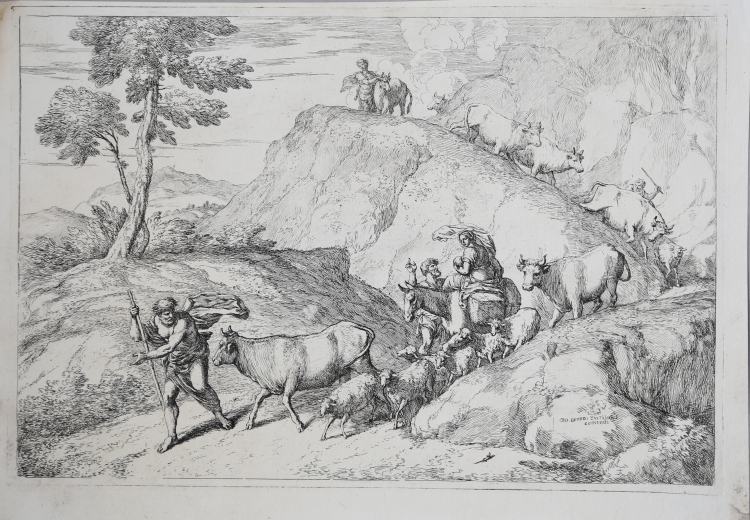



| Reference: | S16905 |
| Author | Gaetano ZOMPINI |
| Year: | 1760 ca. |
| Measures: | 430 x 295 mm |


| Reference: | S16905 |
| Author | Gaetano ZOMPINI |
| Year: | 1760 ca. |
| Measures: | 430 x 295 mm |
Etching and drypoint, circa 1760, lacking date and editorial markings. Only state.
After a drawing by Giovan Battista Castiglione.
From the series “Varii Capricci, e paesi inventati, e disegnati dal celebre Gio. Benedetto Castiglione Genovese tratti dalla raccolta zanettiana. Incisi all'acquaforte da Gaetano Zompini Pittore Veneto. Ora novamente raccolti, e pubblicati”, published in Venice in 1786.
This edition of 1786 includes a frontispiece, engraved by Giuseppe Maria Del Pian, and 12 plates, the first three of which are dedicated to the education of Achilles. Since three plates of the series are dated 1758 and two 1759, it is likely that a first edition of the series, without frontispiece, and limited to very few copies, was completed around 1760. The collection was reissued in 1786 on the initiative of John Strange became the owner, through the agent Giovanni Maria Sasso, of the plates purchased from the heirs Zanetti.
Five plates of the series bear the monogram AMZ of Antonio Maria Zanetti to whom, in the past, were erroneously attributed all the engravings. The theory was also supported by the fact that four prints bear at the bottom, in the first state, the dedication to people who were friends of Zanetti, and by the letter of January 16, 1759 in which Algarotti, writing to Zanetti, praised two prints derived from drawings by Castiglione.
Santifaller, on the other hand, pointed out the stylistic affinities between the prints derived from Castiglione and those of Zompini, attributing the engravings to him. Sopher suggests that Zanetti added his monogram and dedications to friends and relatives in order to pass the prints off as his own, as a sort of joke. Algarotti would have been one of the recipients who were duped. Bozzolato (1978) suggested that Zanetti started the work but then handed it over to Zompini, "without a doubt the real author".
The collaboration with Zanetti would be limited to a few plates, probably the five bearing the AMZ monogram.
Magnificent proof, printed on contemporary laid paper with watermark of the "three half moons", with margins, in good condition.
Bibliografia
D. Succi, La Serenissima nello specchio di rame, pp. 765-769, n. 69; Bozzolato 7, TIB p. 117, 80.
Gaetano ZOMPINI (Mervesa 1702 - Venezia 1778)
|
Italian painter and engraver. He studied when very young with Nicolò Bambini (1651–1736), and later became a follower of Sebastiano Ricci. Before 1733 he executed a series of frescoes for S Nicolò da Tolentino, Venice, which included the Four Evangelists on the pendentives, Old Testament scenes on the drum, and, in the dome, the Holy Trinity. Of another early fresco cycle, in the church of the Servi at Gradisca, near Gorizia, only the vault fresco, the Apparition of the Blessed Virgin in Glory, survives. Zompini’s most considerable work as a history painter was a series of eight dramatic canvases, in a style reminiscent of Ricci and Giambattista Tiepolo, of scenes from Homer and Virgil, and seven monochrome overdoors representing Olympian deities, on a gold background, painted for the Palazzo Zinelli, Venice (all 1736; Moschen Castle, near Kujau, Silesia, Tiele-Winckler priv. col.).
|
Gaetano ZOMPINI (Mervesa 1702 - Venezia 1778)
|
Italian painter and engraver. He studied when very young with Nicolò Bambini (1651–1736), and later became a follower of Sebastiano Ricci. Before 1733 he executed a series of frescoes for S Nicolò da Tolentino, Venice, which included the Four Evangelists on the pendentives, Old Testament scenes on the drum, and, in the dome, the Holy Trinity. Of another early fresco cycle, in the church of the Servi at Gradisca, near Gorizia, only the vault fresco, the Apparition of the Blessed Virgin in Glory, survives. Zompini’s most considerable work as a history painter was a series of eight dramatic canvases, in a style reminiscent of Ricci and Giambattista Tiepolo, of scenes from Homer and Virgil, and seven monochrome overdoors representing Olympian deities, on a gold background, painted for the Palazzo Zinelli, Venice (all 1736; Moschen Castle, near Kujau, Silesia, Tiele-Winckler priv. col.).
|